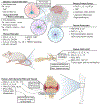Host transcriptome response to Borrelia burgdorferi sensu lato
- PMID: 33360384
- PMCID: PMC8127729
- DOI: 10.1016/j.ttbdis.2020.101638
Host transcriptome response to Borrelia burgdorferi sensu lato
Abstract
The host immune response to infection is a well-coordinated system of innate and adaptive immune cells working in concert to prevent the colonization and dissemination of a pathogen. While this typically leads to a beneficial outcome and the suppression of disease pathogenesis, the Lyme borreliosis bacterium, Borrelia burgdorferi sensu lato, can elicit an immune profile that leads to a deleterious state. As B. burgdorferi s.l. produces no known toxins, it is suggested that the immune and inflammatory response of the host are responsible for the manifestation of symptoms, including flu-like symptoms, musculoskeletal pain, and cognitive disorders. The past several years has seen a substantial increase in the use of microarray and sequencing technologies to investigate the transcriptome response induced by B. burgdorferi s.l., thus enabling researchers to identify key factors and pathways underlying the pathophysiology of Lyme borreliosis. In this review we present the major host transcriptional outcomes induced by the bacterium across several studies and discuss the overarching theme of the host inflammatory and immune response, and how it influences the pathology of Lyme borreliosis.
Keywords: Borrelia burgdorferi; Borreliosis; Host transcriptome; Lyme.
Copyright © 2020 The Author(s). Published by Elsevier GmbH.. All rights reserved.
Figures




Similar articles
-
Borrelia burgdorferi hijacks cellular metabolism of immune cells: Consequences for host defense.Ticks Tick Borne Dis. 2020 May;11(3):101386. doi: 10.1016/j.ttbdis.2020.101386. Epub 2020 Feb 3. Ticks Tick Borne Dis. 2020. PMID: 32035898 Review.
-
Isolation of live Borrelia burgdorferi sensu lato spirochaetes from patients with undefined disorders and symptoms not typical for Lyme borreliosis.Clin Microbiol Infect. 2016 Mar;22(3):267.e9-15. doi: 10.1016/j.cmi.2015.11.009. Epub 2015 Dec 8. Clin Microbiol Infect. 2016. PMID: 26673735
-
Immune Response to Borrelia: Lessons from Lyme Disease Spirochetes.Curr Issues Mol Biol. 2021;42:145-190. doi: 10.21775/cimb.042.145. Epub 2020 Dec 8. Curr Issues Mol Biol. 2021. PMID: 33289684 Free PMC article.
-
Epidemiologic, ecologic and clinical characteristics of Lyme borrelliosis in northwest Croatia.Acta Med Croatica. 1998;52(1):7-13. Acta Med Croatica. 1998. PMID: 9599811
-
Borrelia burgdorferi sensu lato, the agent of lyme borreliosis: life in the wilds.Parasite. 2008 Sep;15(3):244-7. doi: 10.1051/parasite/2008153244. Parasite. 2008. PMID: 18814688 Review.
Cited by
-
Cellular and transcriptome signatures unveiled by single-cell RNA-Seq following ex vivo infection of murine splenocytes with Borrelia burgdorferi.Front Immunol. 2023 Dec 8;14:1296580. doi: 10.3389/fimmu.2023.1296580. eCollection 2023. Front Immunol. 2023. PMID: 38149246 Free PMC article.
-
Changes in the Transcriptome and Long Non-Coding RNAs but Not the Methylome Occur in Human Cells Exposed to Borrelia burgdorferi.Genes (Basel). 2024 Aug 1;15(8):1010. doi: 10.3390/genes15081010. Genes (Basel). 2024. PMID: 39202370 Free PMC article.
-
Bridging the gap: Insights in the immunopathology of Lyme borreliosis.Eur J Immunol. 2024 Dec;54(12):e2451063. doi: 10.1002/eji.202451063. Epub 2024 Oct 13. Eur J Immunol. 2024. PMID: 39396370 Free PMC article. Review.
-
A chemosensory-like histidine kinase is dispensable for chemotaxis in vitro but regulates the virulence of Borrelia burgdorferi through modulating the stability of RpoS.PLoS Pathog. 2023 Nov 27;19(11):e1011752. doi: 10.1371/journal.ppat.1011752. eCollection 2023 Nov. PLoS Pathog. 2023. PMID: 38011206 Free PMC article.
-
Anti-chemokine antibodies after SARS-CoV-2 infection correlate with favorable disease course.bioRxiv [Preprint]. 2022 Nov 27:2022.05.23.493121. doi: 10.1101/2022.05.23.493121. bioRxiv. 2022. Update in: Nat Immunol. 2023 Apr;24(4):604-611. doi: 10.1038/s41590-023-01445-w. PMID: 35664993 Free PMC article. Updated. Preprint.
References
Publication types
MeSH terms
Grants and funding
LinkOut - more resources
Full Text Sources
Other Literature Sources
Research Materials
Miscellaneous

